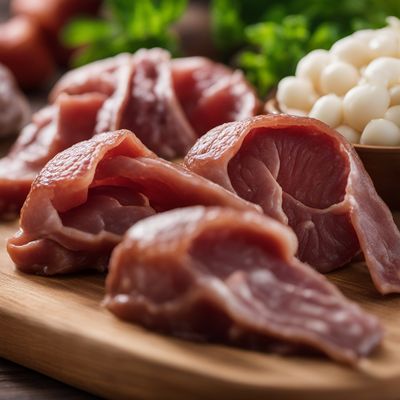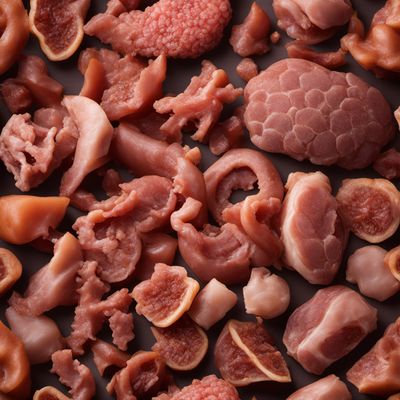
Ingredient
Pig edible offal, non-muscle, other than liver and kidney
Beyond the Ordinary: Exploring the Versatility of Pig Edible Offal
Pig edible offal refers to the non-muscle parts of the pig, excluding the liver and kidney. It encompasses a wide range of organs and tissues, including the heart, lungs, stomach, intestines, and more. These offal cuts offer unique flavors and textures that can elevate dishes and add variety to culinary creations. From hearty stews to delicate pâtés, pig edible offal is a versatile ingredient that deserves recognition.
Origins and history
The consumption of pig offal has a long history in various cultures around the world. Offal cuts were traditionally valued as a way to utilize the whole animal and minimize waste. In many cuisines, pig offal is considered a delicacy and is used in a variety of traditional dishes. Today, it continues to be appreciated for its distinct flavors and textures, offering a range of culinary possibilities.
Nutritional information
Pig edible offal is a good source of protein, vitamins, and minerals. It is particularly rich in iron, zinc, and vitamin B12. However, it is also higher in cholesterol and should be consumed in moderation as part of a balanced diet.
Allergens
Pig edible offal may cause allergic reactions in individuals with pork or meat allergies. It is important to exercise caution and consult with a healthcare professional if you have any known allergies or sensitivities.
How to select
When selecting pig edible offal, look for cuts that are fresh, with a vibrant color and no signs of spoilage. Avoid offal that appears discolored, has an off smell, or shows signs of decomposition. It is best to purchase offal from reputable butchers or specialty meat suppliers.
Storage recommendations
To maintain the freshness and quality of pig edible offal, store it in the refrigerator at a temperature below 40°F (4°C). Wrap it tightly in plastic wrap or place it in an airtight container to prevent exposure to air and odors. Use it within a few days for optimal flavor and texture.
How to produce
Pig edible offal can be produced by raising pigs and properly slaughtering and processing them. However, it requires specialized knowledge and facilities to ensure food safety and quality. It is recommended to leave the production of pig edible offal to professional farmers and butchers.
Preparation tips
Pig edible offal can be prepared in various ways, depending on the specific cut. It can be braised, grilled, roasted, or used in soups, stews, and pâtés. Each offal cut requires different cooking techniques and times, so it is important to follow specific recipes or consult with a knowledgeable chef or butcher for guidance.
Culinary uses
Pig edible offal is widely used in many cuisines around the world. It is a key ingredient in dishes such as haggis, chitterlings, menudo, and pâtés. Offal cuts can also be incorporated into sausages, terrines, and meat pies, adding depth and complexity to the final dish.
Availability
Pig edible offal is commonly available in regions where pork is consumed. It can be found in butcher shops, specialty meat markets, and some supermarkets. However, availability may vary depending on local cultural preferences and demand.
More ingredients from this category

Equine edible offal, non-muscle, other than liver and kidney
Exploring the Hidden Gems of Equine Edible Offal

Goat edible offal, non-muscle, other than liver and kidney
The Hidden Gems of Goat: Exploring the Delicacies of Edible Offal

Wild boar edible offal, non-muscle, other than liver and kidney
Savory Treasures from the Wild

Deer edible offal, non-muscle, other than liver and kidney
The Hidden Gems of Deer: Exploring Non-Muscle Edible Offal

Rabbit edible offal, non-muscle, other than liver and kidney
Unveiling the Hidden Gems: Exploring the Versatile Rabbit Edible Offal

Bovine edible offal, non-muscle, other than liver and kidney
The Hidden Gems of Bovine Offal

Sheep edible offal, non-muscle, other than liver and kidney
Exploring the Delicacies of Sheep Edible Offal

Camel edible offal, non-muscle, other than liver and kidney
Unveiling the Hidden Gems: Exploring the Exquisite Camel Edible Offal